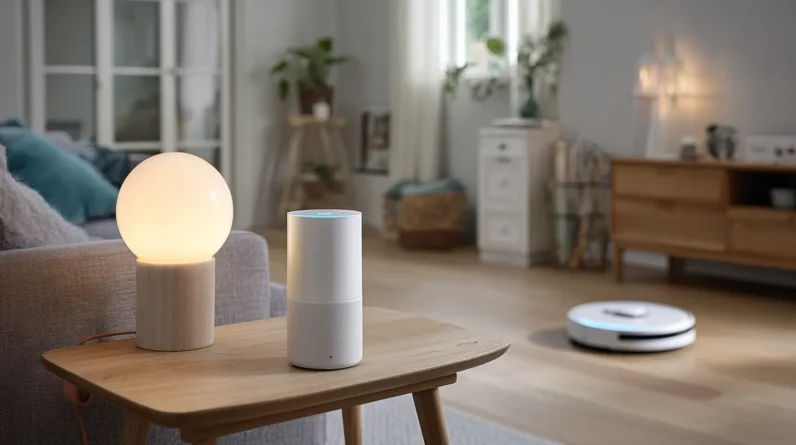
To integrate smart devices into family routines, we’ll want to start by setting clear digital boundaries. Establish tech-free zones and device curfews to maintain balance. Next, leverage smart home automation to streamline daily tasks, like programming lights and thermostats. Don’t forget to explore educational tech opportunities, such as interactive learning apps and virtual reality experiences. Enhance family communication with shared calendars and video calls. Finally, prioritize face-to-face interactions and lead by example in maintaining healthy tech habits. By thoughtfully incorporating these strategies, we can create a harmonious blend of technology and togetherness in our homes. The key lies in striking the right balance for your unique family dynamics.
Establishing Digital Boundaries
Let’s dive into establishing digital boundaries, a crucial step in integrating smart devices into family life. We need to set clear rules for when and where devices can be used. Create tech-free zones, like the dining room or bedrooms, to encourage face-to-face interaction. Implement device curfews, ensuring screens are off at least an hour before bedtime for better sleep hygiene.
We should leverage parental controls and screen time management features built into smart devices. These tools allow us to limit app usage, filter content, and monitor online activities. It’s essential to lead by example, demonstrating responsible device use ourselves. We can also establish a family media plan, outlining agreed-upon rules and consequences for breaking them. By setting these boundaries, we’ll foster a healthier relationship with technology while maximizing the benefits of smart devices in our daily routines.
Smart Home Automation Strategies
Smart home automation strategies can pave the way for a more efficient and connected family life. We’ll start by identifying key areas where automation can streamline our daily routines. Let’s focus on morning and evening rituals, energy management, and security protocols. We can program smart lights to gradually brighten for gentle wake-ups and dim for bedtime routines. Automated thermostats can adjust temperatures based on our family’s schedule, optimizing comfort and energy efficiency.
For security, we’ll set up smart locks and cameras that integrate with our smartphones for real-time monitoring and control. Voice-activated assistants can manage our shopping lists, set reminders, and control other smart devices. By creating custom scenes or routines, we’ll synchronize multiple devices to work in harmony, enhancing our family’s productivity and well-being throughout the day.
Educational Technology for Family Learning
As we embrace the digital age, educational technology becomes a powerful tool for family learning. We can leverage smart devices to create engaging, interactive learning experiences for all ages. Let’s explore apps that turn math into fun games, or language learning platforms that make mastering a new tongue a family challenge. We’ll discover how to use virtual reality headsets for immersive history lessons or science explorations.
Smart speakers can be programmed to quiz family members on various subjects, while tablets can host digital book clubs. We’ll also look into coding kits that teach programming skills through hands-on projects. By integrating these technologies into our daily routines, we’re not just learning; we’re fostering a tech-savvy environment that prepares our families for the future while strengthening bonds through shared educational experiences.
Enhancing Family Communication
Communication forms the backbone of strong family relationships, and smart devices can play a pivotal role in enhancing these connections. We can leverage technology to strengthen our family bonds and improve our interactions. By integrating smart devices into our daily routines, we’re opening up new channels for meaningful exchanges.
Here’s how we can use smart devices to boost family communication:
– Create shared digital calendars for coordinating schedules
– Utilize video calling for face-to-face interactions when apart
– Set up family group chats for quick updates and shared moments
– Implement smart home assistants for centralized family announcements
These tech-driven strategies help us stay connected in our fast-paced lives. We’re not just adopting new gadgets; we’re revolutionizing how we interact as a family unit. By embracing these tools, we’re fostering a tech-savvy environment that encourages open dialogue and constant connectivity, ensuring our family ties remain strong in the digital age.
Balancing Screen Time and Togetherness
The digital age presents a unique challenge: how do we balance the benefits of smart devices with quality family time? We must establish clear boundaries and implement strategies to ensure technology enhances, rather than hinders, our relationships. Let’s create device-free zones in our homes, particularly during meals and family activities. We can use screen time management apps to set limits and monitor usage across all family devices. It’s crucial to lead by example, demonstrating healthy tech habits ourselves.
We should prioritize face-to-face interactions and engage in tech-free activities regularly. By scheduling dedicated family time without devices, we’re fostering stronger connections. Remember, it’s not about eliminating technology, but about integrating it mindfully. We can leverage smart devices to streamline tasks, freeing up more time for meaningful interactions and shared experiences.
Conclusion
As we’ve explored, integrating smart devices into our family routines isn’t just about gadgets—it’s about crafting a digital ecosystem that enhances our lives. We’re not just keeping up with the Joneses; we’re pioneering a new frontier of family interaction. By setting boundaries, automating wisely, learning together, and fostering communication, we’re creating a home where tech doesn’t divide us, but unites us. Let’s embrace this smart revolution, making our homes not just connected, but truly intelligent.







